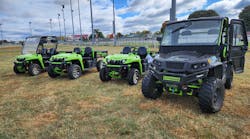How green is your landscape—and your landscaping equipment?
Traditionally, landscapers have used gasoline-powered products to tune up their grounds. There are two key problems associated with this, according to Jason Swanson, vice president of global product development for Greenworks Commercial, a leading provider of battery-powered electric landscaping solutions:
- Burning gasoline emits harmful carbon dioxide, which raises the carbon footprint of your landscape.
- Fueling up carries an inherent risk of spills. Researchers have estimated that roughly 1,500 liters of gas are spilled each decade at gas stations alone. This figure doesn’t account for spills that might happen on your premises, where they’re not being tracked.
In addition to the potential environmental impacts of gasoline, laws and ordinances restricting emissions are emerging at the federal, state and local levels, Swanson adds. That’s driving more landscapers and grounds management crews to convert from gas products to battery-operated electric models when it’s time to replace equipment.
“We all need to play a part in reducing our carbon footprint,” Swanson said. “Converting gas equipment to electric is one of the easiest ways for an organization to commit to helping make this transition impactful.”
Greenworks Commercial recently hosted BUILDINGS and other publications for a media day in which the company discussed how they are tackling these common issues associated with gasoline-powered equipment.
Trends in Battery-Operated Electric Tools
Battery-operated electric landscaping equipment has come a long way in the last couple of decades. Greenworks Commercial is now including GPS and cloud technology in its landscaping equipment so facilities professionals can track equipment location and status remotely. Users can also create geofences for theft protection and receive an alert when the unit leaves the selected area, then provide the GPS coordinates of the unit to the appropriate authorities.
The new landscaping equipment also features:
- Speed: One of the new tools introduced at the Greenworks Commercial media day was the Optimus Z. Billed as the “fastest mower on the market,” the ride-on mower features a 16 mph cut speed and can handle a 25-degree slope. It can mow 19,000 feet per minute and adjusts to any grass condition.
- Battery capacity and charging speed: Some of the equipment introduced at the event is capable of charging in a short time; for example, the new 30-inch cordless walk-behind mower charges in just 30 minutes and runs for up to 110 minutes, mowing up to 2 acres in that time. Battery technology has also grown significantly in terms of capacity; the new X-Series X6 82V battery pack, which powers handheld landscaping equipment, can achieve 2,500 cycles at 70% state of charge (SoC), twice as long as traditional batteries.
- Ease of charging: The new OptimusMC Mobile Charging Trailer gives facilities professionals an easier way to charge equipment on the go. Simply power up the trailer’s 26 kWh battery module with a standard Level 1 or 2 EV charger overnight, then take the trailer to wherever crews are working. Solar panels on top of the trailer top off the batteries throughout the day.
The 82V batteries that power handheld equipment should deliver three to five years of frequent usage, while the internal batteries used for larger equipment should last at least five to seven years, Swanson said. All batteries can be recycled at the end of their life through a nationwide network of recycling centers, such as Call2Recycle. Over 90% of the battery components can be reclaimed.
Why Switch?
Implementing battery-powered landscaping equipment isn’t just a more sustainable option—it can also have a positive financial impact for your organization, Swanson said. While savings vary depending on how much of your equipment is replaced by battery-powered models, facilities owners and managers are likely to see savings from several arenas, including “no more gas, no spark plugs, no filters [and] no belts,” as well as eliminating the need to maintain these items, Swanson said.
“[There is a] slightly higher initial investment, but a return on investment can be realized in less than a year,” Swanson added. “You’ll spend more time on the lawn vs. refueling or maintenance.”



